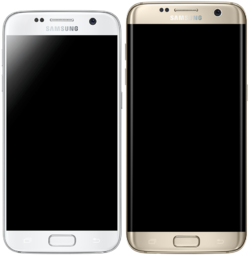 | |
 Samsung Galaxy S7 in White and S7 Edge in Gold | |
| Brand | Samsung |
|---|---|
| Manufacturer | Samsung Electronics |
| Type | Smartphone |
| Series | Galaxy S |
| Family | Samsung Galaxy |
| First released | S7 and S7 Edge: February 21, 2016 S7 Active: June 4, 2016 |
| Availability by region | S7 and S7 Edge: March 11, 2016 S7 Active: June 10, 2016 [1] |
| Discontinued | April 21, 2017 |
| Units sold | According to a report from Strategy Analytics, the combined sales of the two smartphones reached 55 million units at the end of the first quarter of 2017. In the first three months of the year, the tech giant sold 7.2 million units of last year’s flagships. |
| Predecessor | Samsung Galaxy S6 |
| Successor | Samsung Galaxy S8 |
| Related | Samsung Galaxy Note 7 Samsung Galaxy Note FE Samsung Galaxy A8 (2016) Samsung Galaxy A3 (2017) Samsung Galaxy A5 (2017) Samsung Galaxy A7 (2017) |
| Compatible networks | |
| Form factor | Slate |
| Dimensions |
|
| Weight |
|
| Operating system | Original: Android 6.0.1 "Marshmallow" with TouchWiz Hero UX Current: Android 8.0 "Oreo" with Samsung Experience 9.0 Unofficial alternative: Up to Android 12, One UI 4.1 |
| System-on-chip | Global: Samsung Exynos 8890 USA and China: Qualcomm Snapdragon 820 |
| CPU |
|
| GPU | Exynos: Mali-T880 MP12 Snapdragon: Adreno 530 |
| Memory | 4 GB LPDDR4 RAM |
| Storage | 32, 64 or 128 GB UFS 2.0 |
| Removable storage | microSDXC, expandable up to 256 GB |
| SIM | 1x or 2x nanoSIM |
| Battery | All internal:
|
| Charging | Wired: Qualcomm Quick Charge 2.0 up to 15 W Wireless: Qi and AirFuel Inductive wireless charging up to 7.5 W |
| Rear camera | Samsung ISOCELL S5K2L1 or Sony Exmor RS IMX260 [2] 12 MP (4032×3024), 1.4 μm pixel size, f/1.7 aperture, [3] [4] 2160p(4K) at 30fps(limited to 10 m since Android 7 update), 1440p(QHD) at 30fps, 1080p at 30/60fps, 720p at 30/60fps, real-time slow motion video recording at 720p@240fps [5] |
| Front camera | Samsung S5K4E6 5 MP (2592×1464), f/1.7 aperture, 1440p/1080p/720p video recording [6] |
| Display |
|
| External display | Always-on display |
| Connectivity | Wi-Fi 802.11a/b/g/n/ac (2.4 & 5 GHz), Bluetooth 4, 4G/LTE |
| Water resistance | IP68, up to 1.5 m (4.9 ft) for 30 minutes |
| Model |
|
| Codename | Project Lucky (herolte, [7] hero2lte [7] ) Poseidon (S7 Active) [8] |
| Website | www |
The Samsung Galaxy S7 series are Android-based smartphones manufactured, released and marketed by Samsung Electronics. The S7 series served as the successor to the Galaxy S6, S6 Edge, S6 Active and S6 Edge+ released in 2015. The S7 and S7 Edge were officially unveiled on 21 February 2016 during a Samsung press conference at Mobile World Congress, with a European and North American release on 11 March 2016. [9] [10] The Samsung Galaxy S7 Active was unveiled on 4 June 2016, and released on AT&T in the United States on 10 June 2016. [1]
Contents
- Specifications
- Hardware
- Software
- Reception
- Sales
- Known issues
- Variants
- Galaxy S7
- Galaxy S7 Edge
- Galaxy S7 Active
- See also
- References
- External links
The Samsung Galaxy S7 was an evolution of the prior year's model, with upgraded hardware, design refinements, and the restoration of features removed from the Galaxy S6, such as IP68 certification for water and dust resistance, as well as expandable storage with a MicroSD card. Succeeding the S6 and S6 Edge+, respectively, the Samsung Galaxy S7 was produced in a standard model with a display size of 5.1-inch (130 mm) as well as an Edge variant whose display is curved along the wide sides of the screen and also has a larger 5.5-inch (140 mm) display. The S7 Active features a thicker and more rugged frame, with an increased battery capacity. The Galaxy S7 and S7 Edge are the last two phones in the Samsung Galaxy S series to have a physical home button with a front-sided fingerprint sensor embedded in the button. The S7 Active is the last in the Active series to feature three physical buttons with the fingerprint reader embedded home button, when not considering the prematurely discontinued Galaxy Note 7. It is the last phone in the Samsung Galaxy S series to be equipped with a microUSB port, which has since been replaced with USB-C technology.
The Samsung Galaxy S7 was succeeded by the Samsung Galaxy S8 in April 2017.

